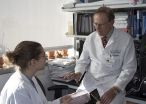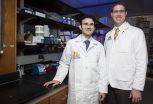(Press-News.org) This news release is available in German.
The immune system functions as the body's police force, protecting it from intruders like bacteria and viruses. However, in order to ascertain what is happening in the cell it requires information on the foreign invaders. This task is assumed by so-called immunoproteasomes. These are cylindrical protein complexes that break down the protein structures of the intruders into fragments that can be used by the defense system.
"In autoimmune disorders like rheumatism, type 1 diabetes or multiple sclerosis as well as severe inflammations a significantly increased immunoproteasome concentration can be measured in the cells," explains Prof. Michael Groll at the TUM Chair of Biochemistry. "The deactivation of this degradation machinery suppresses the regeneration of immune signaling molecules, which, in turn, prevents an excessive immune reaction."
Subtle but significant differences
For some time now, scientists have been on the lookout for new active substances that block immunoproteasomes in a targeted manner without inhibiting the so-called constitutive proteasomes also present in cells. They break down defective or no longer required proteins and are thus responsible for cellular recycling. Notably cell death occurs, when both the constitutive proteasomes and the immunoproteasomes are inactivated.
In early 2012 the research team led by Groll fulfilled a prerequisite for designing specific active substances: They solved the crystal structure of the immunoproteasome, allowing them to spot the subtle but significant differences between the otherwise nearly identical structures.
Special mode of action
The potential drug that the researchers developed is based on the epoxyketon ONX 0914, an immunoproteasome inhibitor that is already used in clinical trials. The scientists replaced the epoxyketon with a sulfonylflouride group and modified its positioning on the inhibitor. The result was a new compound that selectively inhibits the immunoproteasome without influencing the constitutive proteasome.
First author Christian Dubiella explains what makes the discovered mechanism so special: "Normally inhibitors clog up the active center of the enzyme and thereby disable its functionality. The substance synthesized by us, however, attaches to its target, causing the active center to destroy itself, and then gets detached after successful inactivation." Especially the insights into the atomic mechanisms that were uncovered using X-ray structure analysis open the door to the custom-tailored development of immunoproteasome inhibitors. This may pave the road for a future generation of medications.
INFORMATION:
About the project:
The research was done in collaboration with working groups led by Prof. Stephan Sieber at the Department of Organic Chemistry II and Prof. Achim Krüger at the Institute of Experimental Oncology and Therapy Research at TUM, as well as Prof. Robert Liskamp at the University of Glasgow. The work was funded by the German Research Foundation DFG (SFB 1035/A2 & DFG GR 1861/10-1), as well as the Excellence Cluster Center for Integrated Protein Science Munich (CIPSM). The X-ray diffraction measurements were conducted at the PXI Beamline of the Paul Scherrer Institute (Villingen, Switzerland).
Publication:
Selective Inhibition of the Immunoproteasome by Ligand-Induced Crosslinking of the Active Site, Christian Dubiella, Haissi Cui, Malte Gersch, Arwin J. Brouwer, Stephan A. Sieber, Achim Krüger, Rob M. J. Liskamp, Michael Groll, Angewandte Chemie, Early view, September 22, 2014 – DOI: 10.1002/anie.201406964
Link: http://onlinelibrary.wiley.com/doi/10.1002/anie.201406964/abstract
Spot on against autoimmune diseases and chronic inflammations
New mechanism for inhibition of the immunoproteasome revealed
2014-09-25
ELSE PRESS RELEASES FROM THIS DATE:
Discovery may lead to better treatments for autoimmune diseases, bone loss
2014-09-25
Scientists have developed an approach to creating treatments for osteoporosis and autoimmune diseases that may avoid the risk of infection and cancer posed by some current medications.
Researchers at Washington University School of Medicine in St. Louis redesigned a molecule that controls immune cell activity, changing the molecule's target and altering the effects of the signal it sends.
Current treatments for bone loss and autoimmune disorders block these molecules and their signals indiscriminately, which over time increases the risk of infections and cancer. The ...
Fossil of multicellular life moves evolutionary needle back 60 million years
2014-09-25
A Virginia Tech geobiologist with collaborators from the Chinese Academy of Sciences have found evidence in the fossil record that complex multicellularity appeared in living things about 600 million years ago – nearly 60 million years before skeletal animals appeared during a huge growth spurt of new life on Earth known as the Cambrian Explosion.
The discovery published online Wednesday in the journal Nature contradicts several longstanding interpretations of multicellular fossils from at least 600 million years ago.
"This opens up a new door for us to shine some light ...
NCI/FDA lung cancer workshop leads to the innovatively designed clinical trials
2014-09-25
DENVER – The recent launch of two clinical trials offer innovative study designs for patients with lung cancer. These clinical trials are the direct result of a National Cancer Institute (NCI) sponsored workshop chaired by Drs. Fred R. Hirsch, Shakun Malik and Claudio Dansky- Ullman, that brought together the NCI Thoracic Malignancies Steering Committee, the US Food and Drug Administration (FDA), academicians, clinicians as well as industry and government stakeholders to discuss issues and challenges related to clinical trial design and biomarkers for lung cancer targeted-therapies.
The ...
Treatment studied to help patients 'burned to the bone'
2014-09-25
An anti-inflammatory treatment, studied in the labs of regenerative medicine specialists and trauma surgeons, may prevent what's become one of the war-defining injuries for today's troops.
Those burned by high-velocity explosive devices are at-risk for heterotopic ossification (HO), in which bone develops in places it shouldn't be, outside the skeleton, in joints, muscles and tendons. The painful condition can make it difficult to move and function and commonly affects patients who suffer burns, automobile accidents, orthopedic surgery and blast injuries and other combat ...
Live long and phosphor: Blue LED breakthrough for efficient electronics
2014-09-25
ANN ARBOR—In a step that could lead to longer battery life in smartphones and lower power consumption for large-screen televisions, researchers at the University of Michigan have extended the lifetime of blue organic light emitting diodes by a factor of 10.
Blue OLEDs are one of a trio of colors used in OLED displays such as smartphone screens and high-end TVs. The improvement means that the efficiencies of blue OLEDs in these devices could jump from about 5 percent to 20 percent or better in the near future.
OLEDs are the latest and greatest in television technology, ...
Study finds global sea levels rose up to 5 meters per century at the end of the last 5 ice age
2014-09-25
Land-ice decay at the end of the last five ice-ages caused global sea-levels to rise at rates of up to 5.5 metres per century, according to a new study.
An international team of researchers developed a 500,000-year record of sea-level variability, to provide the first account of how quickly sea-level changed during the last five ice-age cycles.
The results, published in the latest issue of Nature Communications, also found that more than 100 smaller events of sea-level rise took place in between the five major events.
Dr Katharine Grant, from the Australian National ...
Calming down immune cells could hold key to melanoma treatment
2014-09-25
Immune cells may be responsible for drug resistance in melanoma patients, according to research published in Cancer Discovery.
Cancer Research UK scientists at The University of Manchester found that chemical signals produced by a type of immune cell, called macrophages, also act as a survival signal for melanoma cells.
When the researchers blocked the macrophages' ability to make this signal - called TNF alpha - melanoma tumours were much smaller and easier to treat.
When melanoma patients are given chemotherapy or radiotherapy it causes inflammation, increasing ...
Interactive website helps lower-income smokers to stop smoking
2014-09-25
People with lower incomes attempting to quit smoking are 36% more likely to succeed if they use a new interactive website called 'StopAdvisor' than if they use a static information website, finds a randomised controlled trial led by UCL researchers. The trial was funded by the National Prevention Research Initiative, a consortium of 16 UK health research funders.
A total of 4,613 smokers took part in the study, of whom 2,142 were classified into a 'lower income' group who had never worked, were long term unemployed or from routine or manual occupations (lower socioeconomic ...
Skirt size increase linked to 33 percent greater postmenopausal breast cancer risk
2014-09-25
Overall weight gain during adulthood is known to be a risk factor for breast cancer, but a thickening waist seems to be particularly harmful, indicating the importance of staving off a midriff bulge, the research shows.
The researchers base their findings on almost 93,000 women taking part in the UK Collaborative Trial of Ovarian Cancer Screening (UKCTOCS) in England.
The women were all aged over 50, had gone through the menopause, and had no known breast cancer when they entered the study between 2005 and 2010.
At enrolment they provided detailed information on height ...
The Lancet Diabetes & Endocrinology: Working long hours linked to increased risk of type 2 diabetes
2014-09-25
People working for more than 55 hours per week doing manual work or other low socioeconomic status jobs have a 30% greater risk of developing type 2 diabetes, according to the largest study in this field so far, published in The Lancet Diabetes & Endocrinology.
Mika Kivimäki, Professor of Epidemiology at University College London, UK, and colleagues conducted a systematic review and meta-analysis of published studies and unpublished individual-level data examining the effects of long working hours on type 2 diabetes up to 30 April 2014.
Analysis of data from 4 published ...
LAST 30 PRESS RELEASES:
Numbers in our sights affect how we perceive space
SIMJ announces global collaborative book project in commemoration of its 75th anniversary
Air pollution exposure and birth weight
Obstructive sleep apnea risk and mental health conditions among older adults
How talking slows eye movements behind the wheel
The Ceramic Society of Japan’s Oxoate Ceramics Research Association launches new international book project
Heart-brain connection: international study reveals the role of the vagus nerve in keeping the heart young
Researchers identify Rb1 as a predictive biomarker for a new therapeutic strategy in some breast cancers
Survey reveals ethical gaps slowing AI adoption in pediatric surgery
Stimulant ADHD medications work differently than thought
AI overestimates how smart people are, according to HSE economists
HSE researchers create genome-wide map of quadruplexes
Scientists boost cell "powerhouses" to burn more calories
Automatic label checking: The missing step in making reliable medical AI
Low daily alcohol intake linked to 50% heightened mouth cancer risk in India
American Meteorological Society announces Rick Spinrad as 2026 President-Elect
Biomass-based carbon capture spotlighted in newly released global climate webinar recording
Illuminating invisible nano pollutants: advanced bioimaging tracks the full journey of emerging nanoscale contaminants in living systems
How does age affect recovery from spinal cord injury?
Novel AI tool offers prognosis for patients with head and neck cancer
Fathers’ microplastic exposure tied to their children’s metabolic problems
Research validates laboratory model for studying high-grade serous ovarian cancer
SIR 2026 delivers transformative breakthroughs in minimally invasive medicine to improve patient care
Stem Cell Reports most downloaded papers of 2025 highlight the breadth and impact of stem cell research
Oxford-led study estimates NHS spends around 3% of its primary and secondary care budget on the health impacts of heat and cold in England
A researcher’s long quest leads to a smart composite breakthrough
Urban wild bees act as “microbial sensors” of city health.
New study finds where you live affects recovery after a hip fracture
Forecasting the impact of fully automated vehicle adoption on US road traffic injuries
Alcohol-related hospitalizations from 2016 to 2022
[Press-News.org] Spot on against autoimmune diseases and chronic inflammationsNew mechanism for inhibition of the immunoproteasome revealed



